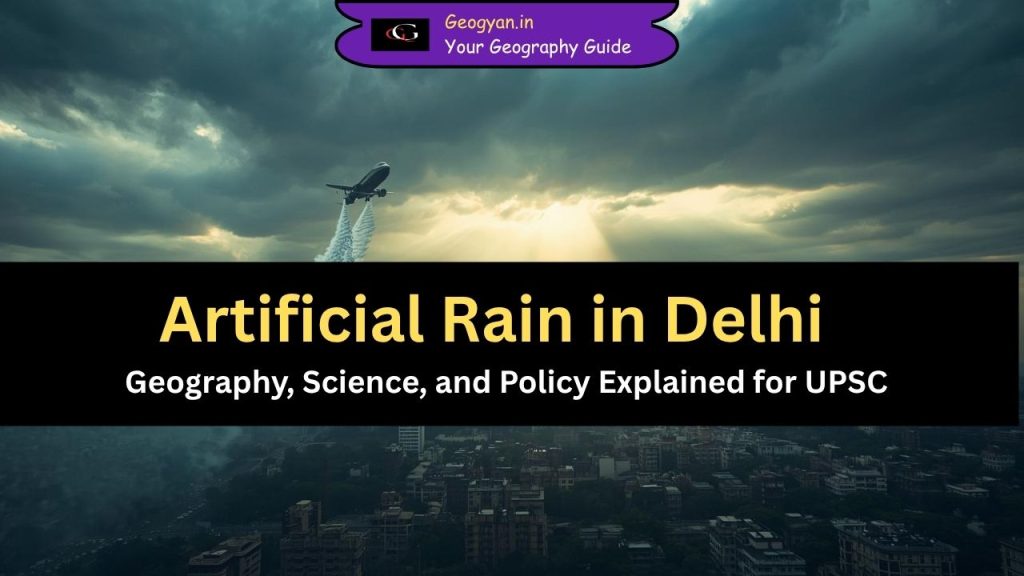Estimated reading time: 4 minutes

Table of contents
Why is Artificial Rain in the News
In a historic step towards fighting Delhi’s rising air pollution, the government has planned to conduct artificial rain for the first time on October 29, 2025.
According to Delhi Chief Minister Rekha Gupta, this initiative comes after a successful trial flight in Burari, where cloud seeding flares were tested between Khekra and Burari.
The experiment was supported by IIT Kanpur scientists, who released a small amount of silver iodide (AgI) into the atmosphere. Although there was no actual rainfall due to low moisture (below 15%), the test flight confirmed the readiness of aircraft and seeding equipment.
This trial marks a major step toward using cloud seeding technology to improve air quality in India’s most polluted city.
What Is Artificial Rain?
Artificial rain, also called cloud seeding, is a weather modification technique that aims to induce rainfall by dispersing certain substances into the air.
These substances — usually silver iodide, sodium chloride, or dry ice — act as nuclei for condensation, helping water vapor in the clouds to aggregate and form raindrops.
For successful artificial rain, the moisture level in the atmosphere should be at least 50%. When the level is too low, the process does not lead to actual precipitation, as seen in the Delhi trial.
Important Note: The concept of cloud seeding was first demonstrated in the 1940s by scientists Vincent Schaefer and Irving Langmuir in the United States.
Why Is Artificial Rain Needed in Delhi?
Delhi has been struggling with severe air pollution, especially during winter months, due to stubble burning, vehicular emissions, and industrial smoke.
Artificial rain can help by:
- Washing away suspended pollutants like PM2.5 and PM10.
- Increasing humidity, which reduces dust resuspension.
- Improving air quality temporarily during critical pollution periods.
Thus, this project aims to create a scientific method to combat pollution while maintaining environmental balance.
How Does Cloud Seeding Work Scientifically?
Let’s understand the geographical and meteorological process behind cloud seeding:
- Identification of suitable clouds – Meteorologists identify clouds containing adequate supercooled water droplets.
- Seeding substance release – Aircraft release silver iodide or sodium chloride into the clouds.
- Microphysical change – These particles trigger crystal formation, encouraging water vapor to condense.
- Droplet growth and precipitation – Condensed droplets combine and fall as rain when heavy enough.
This process mimics natural rainfall, using scientific intervention in the hydrological cycle.
Geographical Context: Global Use of Artificial Rain
Artificial rain is not new to the world.
- China used large-scale cloud seeding before the 2008 Beijing Olympics to ensure clear skies.
- United Arab Emirates and Saudi Arabia use it regularly to enhance rainfall in arid regions.
- Thailand has a Royal Rainmaking Project since the 1950s.
India’s efforts have been limited, but states like Maharashtra and Karnataka have used cloud seeding to tackle drought conditions.
Now, Delhi’s project adds an urban pollution-control dimension to India’s weather modification research.
What Are the Environmental Concerns?
Although artificial rain sounds promising, it has certain challenges:
- Chemical pollution: Silver iodide can cause soil or water contamination if used excessively.
- Limited success: Depends heavily on cloud type, moisture content, and wind conditions.
- Cost and logistics: Requires aircraft, meteorological support, and inter-agency coordination.
- Hence, it must be used with scientific precision and environmental responsibility.
Sources: TOI
FAQs
Q1. What is Artificial Rain or Cloud Seeding?
Artificial rain is a method to induce rainfall using silver iodide or salt particles, which help moisture condense into raindrops.
Q2. Why is Artificial Rain being done in Delhi?
To reduce air pollution, improve air quality, and create a scientific model for pollution control during winter smog.
Q3. Who is conducting this project?
The project is led by the Delhi Government in collaboration with IIT Kanpur and supported by IMD scientists.
Q4. What chemical is used for Artificial Rain?
Silver iodide (AgI) is used as a cloud seeding agent to initiate condensation.
Q5. Does Artificial Rain have side effects?
Excessive use may cause minor soil or water contamination, so controlled use is necessary.
Also Read





























